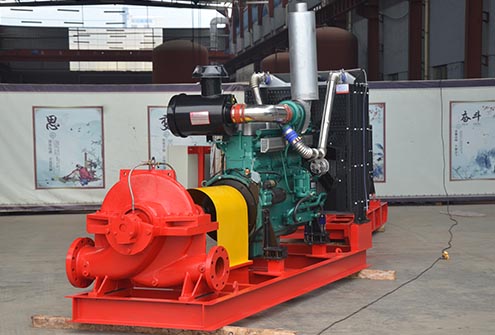Diesel engine fire pump on-site commissioning steps and precautions:
After check and make sure that the installation meets the requirements, first check whether the control cabinet is properly connected to the diesel engine fire pump, and whether the terminal box of the diesel fire pump corresponds to the terminal of the control cabinet.
Check whether the tank water is completely filled. In order to better ensure the overall performance of the diesel fire pump, it is recommended to add pure water or distilled water. Antifreeze should be added in winter, and its frequency of use should be determined according to the local climate and environment;
Check the oil level of the diesel engine fuel tank with the oil field. In the cold state of the first use of the diesel engine, ensure that the oil level is about 1cm higher than the high oil level mark of the oil meter, because when the diesel fire pump is used for the first time, all lubricating meshing components such as oil pipes and gears need to be filled and pre-lubricated. . When the diesel engine is running, the oil level should not be lower than the minimum oil level gauge;
Check whether the proper dosage is added to the diesel, and generally estimate the amount of diesel added based on the power and use duration. Diesel can be added according to the local ambient temperature 10, 0, 10, 20, 35 # light diesel oil, 10 # light diesel oil can be used in high temperature areas, and -35 or lower light diesel oil can be used in cold northern areas;
Add one or two drops of oil to the turbocharger;
The method of checking the oil level of the clutch (optional) is as follows: there are the highest and lowest oil level marks before and after the cold state and the oil gauge. When adding oil for the first time, you should add it to the highest oil dipstick in a cold state. During operation, the oil level cannot be lower than the minimum oil level scale; when the clutch is first run, the oil pressure needs to reach 0.3Mpa. It can only operate when it reaches 0.5MPa.
Check that the battery voltage meets the startup requirements. If the battery is under pressure, it should be charged to 27-28v with the listed power supply. It is best to restart the battery. In addition, when fixing the battery and the motor with a wrench, the battery knife switch should be turned off to prevent the battery from short-circuiting, causing battery damage or larger accident
After the above preparations are completed, the next step of control debugging can be carried out. In order to carry out debugging safely and reliably, the diesel engine fire pump can also be disconnected from the load and run empty. When the engine is turned on for the first time, the oil circuit actuator or solenoid valve should be disconnected to cut off the oil circuit. The diesel flywheel should run for one week. After stopping, use a hexagon socket to loosen the oil outlet bolt, and check whether the oil circuit is full of meshing lubrication and whether the oil circuit is smooth.
Turn off all circuit breakers in the cabinet, observe whether the corresponding relays are working normally, and whether the panel current and voltage display values are normal. If the voltage is too low, charge until the voltage is normal. During the charging process, check whether the current is normal and check the indicator lights and display gauges to see if they are normal (except for overhaul, you usually need to turn off the circuit breaker. When the engine of the diesel fire pump stops, you need to rely on market power to charge the battery. In order to avoid long-term use of the battery with low voltage, it may cause the voltage is too low for emergency operation, and the diesel engine fire pump cannot be started in time. If all the above is normal, follow-up operation can be performed (if the diesel engine fire pump is under load debugging, the pump chamber air should be discharged first, taking the emergency diesel engine fire pump as an example).
Emergency manual operation (put the switch SA into the emergency device):
The emergency manual operation unit (EMU) is mainly for diesel engines that can still be used independently when the PLC is damaged, and its control process is independent of the other two modes.
(1) Emergency start: Press the emergency start button sb1, to cut off the market charging power and enter the 10s (set) startup process until the diesel engine is successfully ignited. Release the button and the diesel engine enters idling operation. Automatically put into high-speed files with a delay of 10 (the specific time is based on debugging).
(2) Emergency stop: Press the emergency stop button SB2 until the diesel engine idling (700-800R/min) , releases the button, delay the stop by 5S idling speed, and then rotate the solenoid valve of the diesel fueling circuit to the closed position. So far, The diesel engine has completed the shutdown process.
(3) Emergency start-stop reset: When the emergency start-stop is completed, press the FA2 emergency start-stop reset button to reset before the next start. To avoid frequent damage to the starting motor, the interval between the two should be more than 2 minutes.

